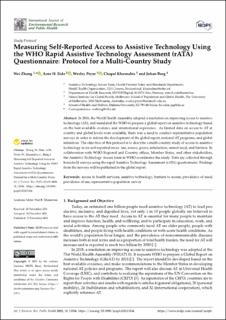Measuring Self-Reported Access to Assistive Technology Using the WHO Rapid Assistive Technology Assessment (rATA) Questionnaire: Protocol for a Multi-Country Study
Peer reviewed, Journal article
Published version

View/
Date
2021Metadata
Show full item recordCollections
- Publikasjoner fra CRIStin - SINTEF AS [5801]
- SINTEF Digital [2501]
Original version
International Journal of Environmental Research and Public Health (IJERPH). 2021, 18 (24), 13336. 10.3390/ijerph182413336Abstract
In 2018, the World Health Assembly adopted a resolution on improving access to assistive technology (AT), and mandated the WHO to prepare a global report on assistive technology based on the best available evidence and international experience. As limited data on access to AT at country and global levels were available, there was a need to conduct representative population surveys in order to inform the development of the global report, national AT programs, and global initiatives. The objective of this protocol is to describe a multi-country study of access to assistive technology in six self-reported areas: use, source, payer, satisfaction, unmet need, and barriers. In collaboration with WHO Regional and Country offices, Member States, and other stakeholders, the Assistive Technology Access team in WHO coordinates the study. Data are collected through household surveys using the rapid Assistive Technology Assessment (rATA) questionnaire. Findings from the surveys will be published in the global report.
